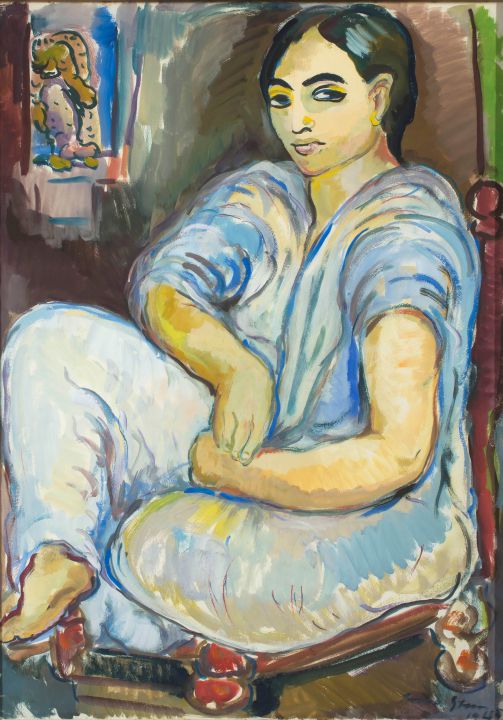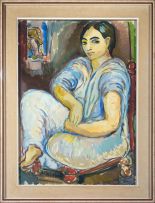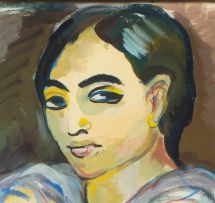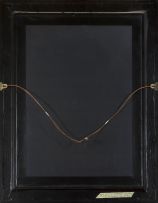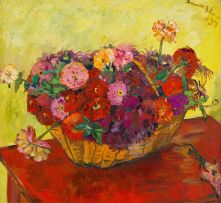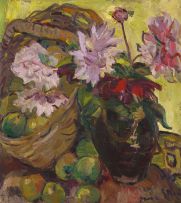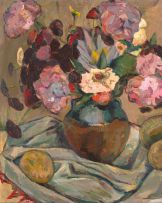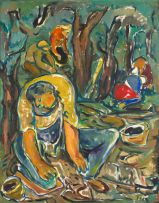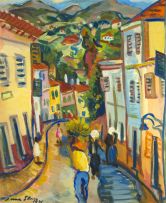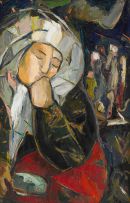Modern, Post-War and Contemporary Art, Decorative Arts, Jewellery and Fine Wine
Live Virtual Auction, 8 - 11 November 2020
The Tasso Foundation Collection
Incl. Buyer's Premium & VAT
About this Item
signed and dated 1945
Notes
Executed on her second trip to Zanzibar in 1945, this gouache of a seated woman captures the unusually direct gaze of Irma Stern's sitter, recording a rare moment of feminine agency in an otherwise patriarchal society. As she would write in her eponymous travel journal, Zanzibar, which was published three years later in 1948, 'The Arab may marry two or more wives. The women do not count, they have no say in the men's lives. They bring children into the world, they cook, they direct servants, but they are of no consequence…'1
Stern was, by this stage in her life, a fiercely independent woman, and well-travelled. She had been divorced for twelve years and undertaken some of her most exciting journeys to Zanzibar and the Belgium Congo between the years of 1939 and 1946, on her own. Moved to explore the African continent further, due to the outbreak of the Second World War curtailing any chance of European travel, Stern's views at once reflect the overarching prejudices of the time whilst signalling a deeper sense of justice as to the role of women and universal suffrage in what was an otherwise conservative society.
Thus one can understand Stern's painterly representations of female subjects from this period as an attempt to make visible that which was traditionally unseen. As she would write 'Arab women are still in purdah and only deeply veiled may leave their house'.2 It is then of no surprise that Stern's compositions of these women take place in the secluded domesticity of the harem.
Her journal entries make early reference to these private sanctuaries as 'rooms on the top floor of the house…' where 'heavy perfumes hang in the air - expensive penetrating Eastern perfumes'. Describing the contents of these spaces and their occupant's possessions, Stern writes that they contained 'a multitude of Arab chests filled with their dowries of lovely old eastern silks with heavy gold fringes, trousers ruched at the ankles with the fringes falling over their feet'.3
Particular to the sitter in this composition is her further observation of these interiors as 'rooms laid out with mats over dark red tiles - Persian mats and straw matting in vivid array. In front of the mattress in red silk with heavy stripes of gold brocade edging it - the day bed'.4 In the present lot Stern's subject, seated on her day bed, stares with an uncompromising address at the viewer.
Unseen outdoors, this interior view opens the window into a seductive world that was traditionally kept private, away from the prying eyes of strangers, and especially foreigners. Precisely how Stern was granted access to such intimate settings is unknown, but the direct gaze of the sitter indicates a mutual complicity between painter and subject. It is therefore fair to say that these portraits provide a rare historical record of an internal world that runs contrary to the image of invisibility that most often accompanied the Arabian women of Zanzibar.
1. Irma Stern (1948) Zanzibar, Pretoria: Van Schaik. Page 12.
2. Ibid.
3. Ibid.
4. Ibid.
Provenance
Christie's, London, 21 September 2000, lot 46, with the title Seated Arab Woman.
The Tasso Foundation Collection of Important South African Art assembled by the Late Giulio Bertrand of Morgenster Estate.
